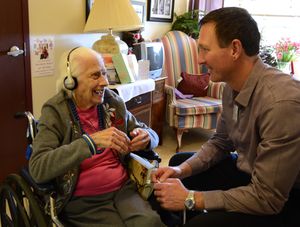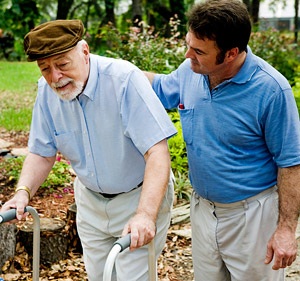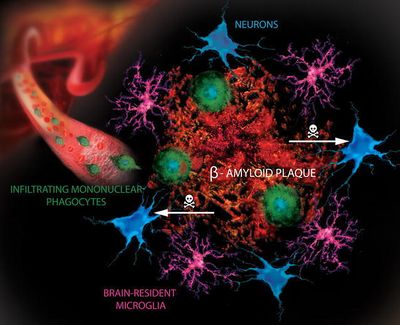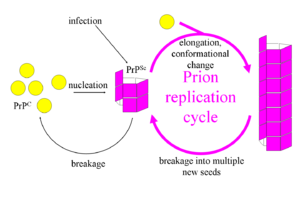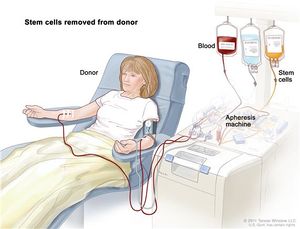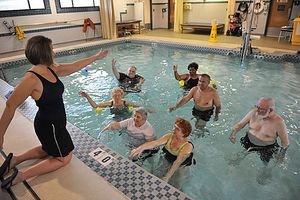Neurodegenerative Disease
Original Editor - Lucinda hampton
Top Contributors - Lucinda hampton and Kim Jackson
Introduction[edit | edit source]
Neurodegenerative disease is an umbrella term for a range of conditions which primarily affect the neurons in the human brain. Neurodegenerative diseases represent a major threat to human health. These age-dependent disorders are becoming increasingly prevalent, in part because the elderly population has increased in recent years.[1]
- Neurons are the building blocks of the nervous system which includes the brain and spinal cord. Neurons normally don’t reproduce or replace themselves, so when they become damaged or die they cannot be replaced by the body.
Neurodegenerative diseases are incurable and debilitating conditions that result in progressive degeneration and / or death of nerve cells. This causes problems with movement (called ataxias), mental functioning (called dementias) and affect a person's ability to move, speak and breathe[1]. Neurodegenerative disorders impact many families - these disorders are not easy for the individual nor their loved ones.
They are diverse in their pathophysiology. Examples of neurodegenerative diseases are:
- Alzheimer’s disease (AD) and other dementias
- Parkinson’s disease (PD) and PD-related disorders
- Prion disease
- Motor neurone diseases (MND)
- Huntington’s disease (HD)
- Spinocerebellar ataxia (SCA)
- Spinal muscular atrophy (SMA)[2][1].
Etiology[edit | edit source]
- Some neurodegenerative disorders are caused by inherited genetic changes. These disorders run in families: the faulty gene is transmitted from parents to their children.eg. Huntington’s disease, and rare cases of motor neurone disease and Alzheimer’s disease.
- The majority of neurodegenerative disorders are due to a combination of genetic and environmental factors. This makes it difficult to predict who will develop disease.
- Specific genetic changes that increase the chance of disease have been identified for some conditions, however in most cases the genetic influences on neurodegenerative disorders are not well understood.
- Environmental factors also contribute to neurodegenerative disorders. eg. There is evidence linking Parkinson’s disease with long-term exposure to pesticides, toxins and chemicals.
- The greatest known risk factor for many neurodegenerative disorders is age.
- In Australia there are more than 350,000 people living with dementia and around 80,000 people with Parkinson’s disease. These figures are likely to rise as the population ages, making neurodegenerative disorders a growing healthcare concern.[3]
- In 2016, an estimated 5.4 million Americans were living with Alzheimer’s disease. An estimated 930,000 people in the United States could be living with Parkinson’s disease by 2020.[4]
Pathology[edit | edit source]
Neurodegenerative disorders are characterized by progressive loss of selectively vulnerable populations of neurons, which contrasts with select static neuronal loss because of metabolic or toxic disorders.
Neurodegenerative diseases can be classified according to
- Primary clinical features (e.g., dementia, parkinsonism, or motor neuron disease),
- Anatomic distribution of neurodegeneration (e.g., frontotemporal degenerations, extrapyramidal disorders, or spinocerebellar degenerations)
- Principal molecular abnormality.
Molecular Abnormality[edit | edit source]
The most common neurodegenerative disorders are amyloidoses, tauopathies, α-synucleinopathies, and TDP-43 proteinopathies. The protein abnormalities in these disorders have abnormal conformational properties. Growing experimental evidence suggests that abnormal protein conformers may spread from cell to cell along anatomically connected pathways, which may in part explain the specific anatomical patterns observed at autopsy.
- Amyloids are insoluble fibrous proteins that have specific structural characteristics, including a β-sheet-rich secondary structure. The protein abnormalities of almost all common neurodegenerative diseases have some characteristics of amyloid. In neurodegenerative diseases, amyloid-like filamentous aggregates are mostly within the cytoplasm of neurons and glia. Extracellular deposits of amyloid can be found in the brain parenchyma as plaques or in the walls of blood vessels as amyloid angiopathy[5]. eg Gerstmann–Sträussler–Scheinker disease (GSS) (A,B), Creutzfeldt–Jakob disease (CJD) (C,D), and Alzheimer’s disease are all Amyloidoses
- Tauopathies: Tau is a type of protein that is part of the structural function of nerves, necessary for nerves to transmit impulses efficiently. Certain diseases can change normal tau into forms that disrupt nerve impulses, and this group of diseases are called tauopathies. Examples include Alzheimer's Disease, Parkinson's Disease and corticobasal degeneration. Many of these diseases develop in the later stages of life, although some develop in middle age or earlier[6]. Tauopathies also include progressive supranuclear palsy (PSP), corticobasal degeneration (CBD), argyrophilic grain disease (AGD) and Pick’s disease.
- Synucleinopathies are a group of neurodegenerative disorders characterized by fibrillary aggregates of alpha-synuclein protein in the cytoplasm of selective populations of neurons and glia. These disorders include Parkinson's disease (PD), dementia with Lewy bodies (DLB), pure autonomic failure (PAF), and multiple system atrophy (MSA). Because of clinical overlap, differential diagnosis is sometimes very difficult. eg Parkinsonism is the predominant symptom of PD, but it can be indistinguishable from the parkinsonism of DLB and MSA. The deposition of aggregates of synuclein in neurons and glia suggests that a common pathogenic mechanism may exist for these disorders[7].
- TDP-43 proteinopathies are a set of neurodegenerative disorders characterized pathologically by cytoplasmic inclusions composed of TDP-43. The pathology has been implicated in three major diseases
- Motor Neuron Disease (vast majority of cases)
- Frontotemporal lobar degeneration
- Limbic-predominant age-related TDP-43 encephalopathy (by definition; often diagnosed clinically as dementia of the Alzheimer type)
- Others neurodegenerative disorders are less well known to feature TDP-43 proteinopathy: Huntington disease; Parkinson disease and variants, eg Perry syndrome, postencephalitic parkinsonism [8]
5. Prion Diseases are asociated with the build up in the brain (and some other organs) of an abnormal or ‘rogue’ form of a naturally occurring cellular protein, known as the prion protein.
(see link)
Diagnosis[edit | edit source]
Neurodegenerative diseases are often presented as a distinct entity, however there is often overlap as you may have noted in the above descriptions, eg for AD and Lewy body pathologies. None of the neurodegenerative disorders have perfect diagnostic accuracy, and neuropathology will continue to be the gold standard for the foreseeable future.
- Studying disease heterogeneity at autopsy is key to understanding discrepancies between clinical and pathological diagnoses. This is a critical concept because there are many efforts to develop biomarkers to diagnose these diseases and to monitor disease progression in clinical trials[5]
Treatment[edit | edit source]
There are currently no drugs to prevent or cure neurodegenerative disorders.
- Medications to control symptoms can be very effective. Other approaches to manage symptoms and maintain daily activities include physiotherapy, speech pathology, occupational therapy and psychiatry. A multidisciplinary approach is typically applied to improve the quality of life for people with neurodegenerative disorders.
- Research is ongoing to find much-needed new treatments for neurodegenerative disorders[3]. One of the most exciting treatments uses stem cells to replace the neurons that have died. With so many brilliant minds working on a cure, hopefully there will soon be help for people with these diseases.[9]
Burden of Neurological Disorders[edit | edit source]
The burden is already high and is increasing further. Neurological disorders and their sequelae are currently estimated to affect as many as a billion people worldwide. These disorders are found among all age groups and in all geographical regions. The number of people with neurological disorders is estimated to increase considerably in years to come. It is forecast that the number of people affected by dementia (already counted in tens of millions) will double every 20 years. . A WHO report states "a clear message emerges: unless immediate action is taken globally, the neurological burden is expected to become an even more serious and unmanageable threat to public health"[10]
Physiotherapy[edit | edit source]
Neurodegenerative disorders are a group of progressive neurological diseases that cause worsening motor, cognitive and autonomic dysfunction over time.
- Recent advances in international research, best-practice evidence, and clinical guidelines have underscored the role of physiotherapy in the management of neurodegenerative disorders.
- Physiotherapy guidelines based on systematic reviews of best available evidence have since been published for many of these conditions[11].
- Most patients are referred to physiotherapists for this treatment.
- See individual links for physiotherapy management.
References[edit | edit source]
- ↑ 1.0 1.1 1.2 Gitler AD, Dhillon P, Shorter J. Neurodegenerative disease: models, mechanisms, and a new hope.Available from;https://www.ncbi.nlm.nih.gov/pmc/articles/PMC5451177/ (last accessed 14.12.2020)
- ↑ JPND research WHAT IS NEURODEGENERATIVE DISEASE? Available from;https://www.neurodegenerationresearch.eu/what/ (last accessed 14.12.2020)
- ↑ 3.0 3.1 WEHI Neurological Disorders Available from:https://www.wehi.edu.au/research-diseases/development-and-ageing/neurodegenerative-disorders (last accessed 14.12.2020)
- ↑ NIH Neurodegenerative diseases Available from: https://www.niehs.nih.gov/research/supported/health/neurodegenerative/index.cfm (last accessed 15.12.2020)
- ↑ 5.0 5.1 Dugger BN, Dickson DW. Pathology of neurodegenerative diseases. Cold Spring Harbor perspectives in biology. 2017 Jul 1;9(7):a028035.Available from:https://www.ncbi.nlm.nih.gov/pmc/articles/PMC5495060/ (accessed 14.12.2020)
- ↑ Wisegeek Taupathies Available from: https://www.wise-geek.com/what-are-tauopathies.htm (last accessed 14.12.2020)
- ↑ MartÌ MJ, Tolosa E, Campdelacreu J. Clinical overview of the synucleinopathies. Movement disorders: official journal of the Movement Disorder Society. 2003 Sep;18(S6):21-7.Available from:https://pubmed.ncbi.nlm.nih.gov/14502652/ (accessed 14.12.2020)
- ↑ Radiopedia TDP-43 proteinopathy Available from;https://radiopaedia.org/articles/tdp-43-proteinopathy?lang=us (last accessed 14.12.2020)
- ↑ Frontiers What are Neurodegenerative Diseases and How Do They Affect the Brain? Available from:https://kids.frontiersin.org/article/10.3389/frym.2018.00070 (accessed 14.12.2020)
- ↑ WHO Chapter 4 Available from: https://www.who.int/mental_health/neurology/chapter_4_neuro_disorders_public_h_challenges.pdf?ua=1 (accessed 14.12.2020)
- ↑ MNCPD The role of physiotherapy in the management of neurodegenerative disorders Available from:https://www.mncpd.com.au/modules/the-role-of-physiotherapy-in-the-management-of-neurodegenerative-disorders (accessed 15.12.2020)
